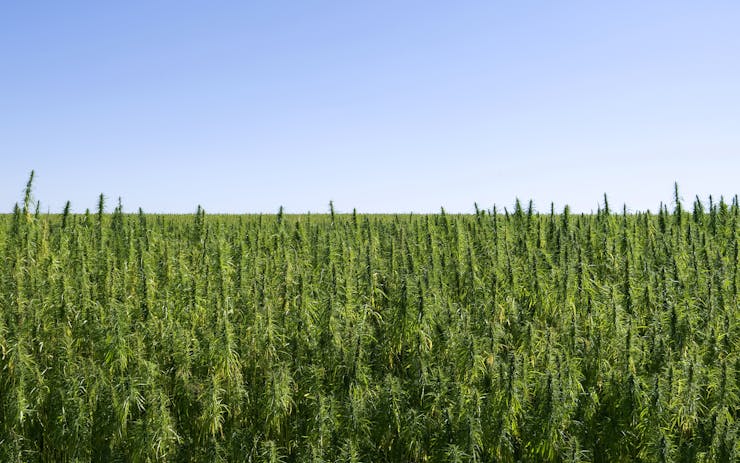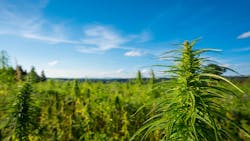Each year hemp farmers in the US legally plant seeds in the ground, tend plants all season, and cross their fingers that they won’t have to destroy the entire crop by harvest time.
The 2018 Farm Bill opened up hemp cultivation in the US, allowing for more expansive hemp cultivation and for hemp-derived products to be sold and even transported across state lines.
Biologically, hemp and cannabis are essentially the same type of plant, but grown for different purposes. Varieties called “cannabis” have traditionally been grown for the medicinal cannabinoids in the flowers of the plant, like THC and CBD; plants called “hemp” were typically grown for their stalks and leaves to make paper, textiles, and industrial goods.
Hemp varieties also contain medicinal cannabinoids like THC and CBD, but very low levels. Today, a lot of farmers grow hemp for CBD.
According to the Farm Bill, legally, the difference comes down to the amount of THC: Any plant with more than 0.3% THC is considered cannabis, and those with less than 0.3% are considered hemp. The cannabis bought in dispensaries that gets you high typically has a THC level above 16%, so under 0.3% is a tiny amount that won’t get you high.
But since cannabis is still federally illegal, unless you live in a state with a legal cannabis program, growing a plant defined as cannabis (over 0.3% THC) instead of hemp (under 0.3% THC) could mean jail time.
According to the United States Department of Agriculture (USDA), any hemp plants that test for more than 0.3% THC must be destroyed, and farmers who don’t comply could face serious criminal charges.
These regulations are based on old definitions of hemp and cannabis. Today, farmers say factors outside of their control are leading to higher test results, and many are fighting against the regulation and arguing to raise the THC limit in hemp to 1% THC.
How 0.3% became the hemp standard
The history of how 0.3% became the THC limit for hemp goes back to Canada and various countries across Europe, who first adopted that standard for hemp farmers in the 1990s. When farmers in the US began to lobby for the right to farm hemp, they followed suit.
“We thought ‘well, we’ve got to go with what the standard is in Canada and Europe because it was going to be harder to make an argument that you needed a different standard,’” said Eric Steenstra, President and Co-Founder of US hemp advocacy group Vote Hemp. “It just sort of became a de facto standard, even though it wasn’t really based on any kind of science.”
At first, it seemed to be working out fine. Hemp-based products, such as body care, food, and textile products, mostly used fiber or seeds, and genetic varieties of hemp aimed at those products rarely produced “hot” results—hemp over the 0.3% THC limit. In those early days of hemp, “They weren’t having a lot of problems with it, like we are today,” said Steenstra.
Why are hemp tests coming in hot in recent years?
But then hemp farmers started to think about hemp as a source for cannabinoids like CBD. Suddenly, hemp farmers were looking for strains that stay below 0.3% THC but still produce high levels of CBD in the hemp flower. It was a tall order given the available genetics.
“The genetics [were] at a pretty early stage. There weren’t a lot available,” said Steenstra, adding, “People had bred different things together trying to come up with plants that would produce an optimal mix of compounds that would still be compliant.”
Unfortunately, it takes time to develop stable genetics. According to Steenstra, “As people were trying to produce more cannabinoids, more CBD, they were pushing up against the edge of the limit of the THC level.”
And even when a variety of hemp was supposedly compliant, unexpected factors could cause hot test results. Environmental factors like latitude and geography, amount of sunlight, soil type, and other environmental stressors can affect how much THC is produced, said Steenstra.
“It causes problems,” said Morris Beegle, Co-Founder & President of hemp brand WAFBA. THC levels might be different “if you’re growing genetics in Colorado versus New York versus Wisconsin, Florida, or whatever.”
And beyond environmental reasons for hot test results, “There are also potential issues with the testing methodology leading to higher levels and more failure rates,” explained Michael Nepveux from the American Farm Bureau Federation (FB).
What happens when hemp tests hot?
As crops get close to harvest time, farmers are required to test their hemp, and if results come in over 0.3% THC, the hemp can’t be removed from the property. In most cases, growers are required to destroy the entire crop. “Law enforcement is notified,” explained Beegle, “then they can come out there and check it, and if they haven’t destroyed it, then you can face penalties.”
Estimates from Pew Trust’s Stateline say 4,309 acres of hemp in 16 states were destroyed last year alone.
Those who don’t comply and destroy the crop no longer have the legal protections of hemp. Their plants are now considered to be cannabis, and getting caught with a full harvest of unregulated cannabis could mean serious jail time.
And testing hot isn’t a rare occurrence.
“A significant amount of crops are testing hot, and it’s just hurting farmers,” said Steentra. “It’s bad for the industry, and it just doesn’t make any sense.” Steenstra also said regulators he’s spoken to estimate between 10-24% of hemp crops have to be destroyed, adding that “If even 10% of those get a hot result, that’s 2,000 producers that lost their crop.”
Estimates from Pew Trust’s Stateline say 4,309 acres of hemp in 16 states were destroyed last year alone—the equivalent of 3,264 football fields in wasted resources.
Some think limit should stay at 0.3%
While hemp advocates champion the move to raise the limit to 1%, Steenstra said some regulators worry that “People are just going to try to grow right up to the limit.” If it’s raised to 1%, everyone will aim for higher and still get hot test results. But Steenstra argues that farmers can be educated to shoot for lower THC numbers, given enough wiggle room.
Others worry that hemp with higher THC may be diverted into the illegal cannabis market, but both Beegle and Steenstra pointed out this is unlikely. “It’s such a minuscule percentage of THC,” explained Beegle. “The intention to grow any of these crops is not to grow it for the psychoactive effects.” He pointed out that THC varieties of cannabis tend to be in the 15-30% THC range, and 1% THC hemp simply won’t offer psychoactive effects.
Another question is whether hemp farmers should be growing for cannabinoids in the first place. According to the FDA, hemp-derived CBD cannot be legally added to food or sold as supplements or medicines. While hemp producers have been skirting these rules and continue to sell consumable types of CBD, it may be hard to make the argument that regulations should shift to support a market that isn’t yet legal.
Cannabis producers, who go through big regulatory hoops and pay large fees to produce consumable CBD for state-legal markets, have also expressed frustration that hemp producers are bypassing these regulations to produce CBD at cheaper rates—and without the high testing and safety standards required for cannabis programs.
Why raise the limit to 1%?
Still, hemp advocates and even mainstream agricultural groups like the American Farm Bureau Federation support raising the THC limit to 1% for a variety of reasons. For one thing, it’s something other countries, such as Thailand, Switzerland, and Mexico are adopting. “That’s going to be a disadvantage to US farmers if we don’t go to 1%,” said Beegle.
Advocates also cited environmental worries. “Given the time, resources, and effort farmers put into growing their crop, that is a lot to throw down the drain if a crop tests above the legal limit,” said Nepveux from the American Farm Bureau Federation.
In addition to the financial risk a farmer takes when growing hemp, hot test results also put them at risk of criminal charges. “We’re trying to criminalize farmers who are the last people we should try to criminalize,” said Beegle. “It’s a waste of time and energy and resources.”
Do you think the THC limit should be raised to 1%? Show your support by signing the petition to raise the limit at Vote Hemp.com.





